Solution:
1) My SQL
Step 1: Create OSGI version of mysql Jar file
Download MySQL JDBC Driver From http://dev.mysql.com/downloads/connector/j
Open eclipse and select file -> New -> Other -> Plugin development -> Plug-in from existing Jar Archive
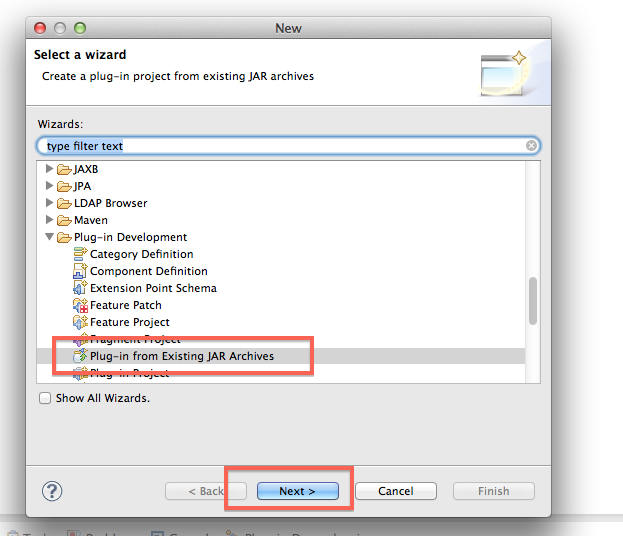
Click next and then select add external. Select jar file you downloaded above and select next
Give Project Name -> Select Location -> Make sure that Analyze Library Content is checked -> In Target Platform select an OSGI framework -> from drop down select standard -> Check unzip jar file and update reference -> click finish
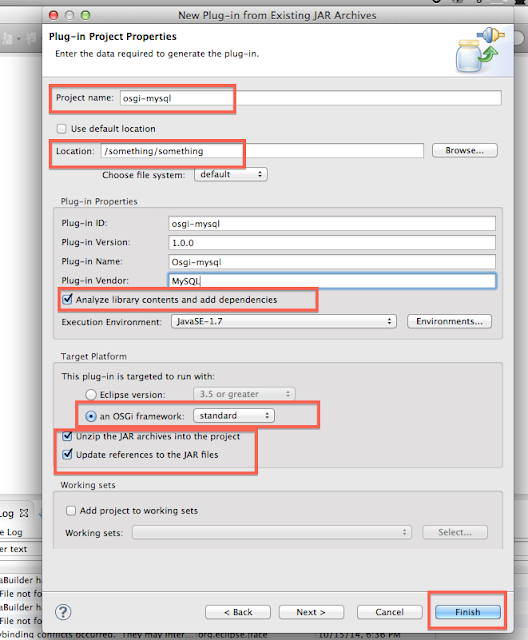
An Plugin Development perspective will open
Click on export tab and make sure that all dependencies are exported (If they are not there, click on add then select all)

Click on Dependencies and make sure that Imported packages are there. If it is not there click on MENIFEST.MF tab and then add following import statement
Once all import and export statement is added your MENIFEST.MF will have the following data
Manifest-Version: 1.0
Bundle-ManifestVersion: 2
Bundle-Name: Mysql-Osgi
Bundle-SymbolicName: com.osgi.mysql
Bundle-Version: 1.0.0
Bundle-RequiredExecutionEnvironment: JavaSE-1.7
Import-Package: javax.management,
javax.naming,
javax.naming.spi,
javax.net,
javax.net.ssl,
javax.sql,
javax.transaction.xa,
javax.xml.parsers,
javax.xml.stream,
javax.xml.transform,
javax.xml.transform.dom,
javax.xml.transform.sax,
javax.xml.transform.stax,
javax.xml.transform.stream,
org.slf4j,
org.w3c.dom,
org.xml.sax,
org.xml.sax.helpers
Export-Package: com.mysql.fabric,
com.mysql.fabric.hibernate,
com.mysql.fabric.jdbc,
com.mysql.fabric.proto.xmlrpc,
com.mysql.fabric.xmlrpc,
com.mysql.fabric.xmlrpc.base,
com.mysql.fabric.xmlrpc.exceptions,
com.mysql.jdbc,
com.mysql.jdbc.authentication,
com.mysql.jdbc.exceptions,
com.mysql.jdbc.exceptions.jdbc4,
com.mysql.jdbc.integration.c3p0,
com.mysql.jdbc.integration.jboss,
com.mysql.jdbc.interceptors,
com.mysql.jdbc.jdbc2.optional,
com.mysql.jdbc.jmx,
com.mysql.jdbc.log,
com.mysql.jdbc.profiler,
com.mysql.jdbc.util,
org.gjt.mm.mysql
Then right click on your project and then select export
Select Deployable Deployable plug-in and fragments
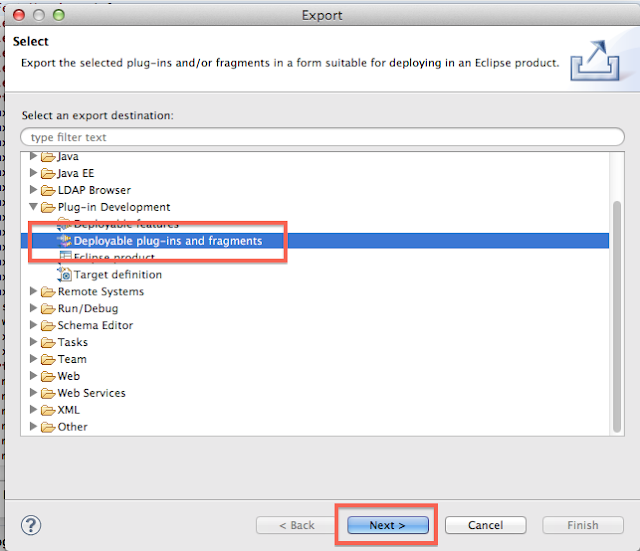
Click Next and select your plug-in
From Directory section select location where you want to upload.
Click finish. This will store OSGI jar in to location you selected.
Once you have MySQL Osgi bundle. Install that bundle either using felix console or adding it through deployment process
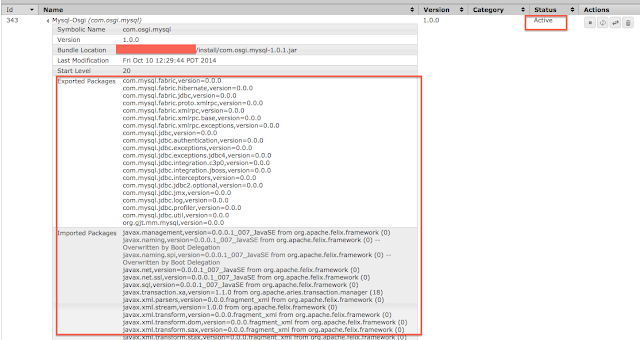
If you are getting error saying javax.Naming not getting resolved then you have to add following line in sling.properties under crx-quickstart folderorg.osgi.framework.bootdelegation= javax.naming.*, ${org.apache.sling.launcher.bootdelegation}
Once bundle is up is running, You need to go to felix osgi config. Search For JDBC connection pool and then click '+'
Fill all the information about your datasource
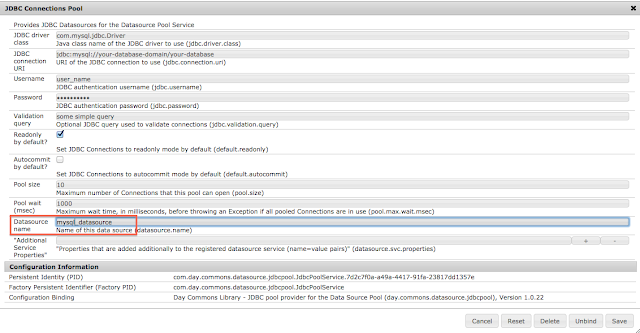
Go to your application logic and test your code
<%@page session="false"%><%
%><%@ page import="com.day.commons.datasource.poolservice.DataSourcePool" %><%
%><%@ page import="javax.sql.DataSource" %><%
%><%@ page import="java.sql.Connection" %><%
%><%@ page import="java.sql.SQLException" %><%
%><%@ page import="java.sql.Statement" %><%
%><%@ page import="java.sql.ResultSet"%><%
%><%@ page import="java.sql.PreparedStatement"%>
%><%@ page import="java.sql.DriverManager"%>
DataSourcePool dspService = sling.getService(DataSourcePool.class);
try {
DataSource ds = (DataSource) dspService.getDataSource("mysql_datasource");
if(ds != null) {
%><p>Obtained the datasource!</p><%
%><%
out.println("Trying to get connection Connection done");
final Connection connection = ds.getConnection();
out.println("Connection done");
final Statement statement = connection.createStatement();
out.println("Create Statement done");
final ResultSet resultSet = statement.executeQuery("some-query'");
int r=0;
while(resultSet.next()){
r=r+1;
}
resultSet.close();
%><p>Number of results: <%=r%></p><%
}
}catch (Exception e) {
%><p>error! <%=e.getMessage()%></p><%
}
If you are having trouble creating osgi version of mysql jar file, You can download it from here
2) Teradata
All the steps for Teradata will remain same except you need to create teradata OSGI bundle using Teradata JDBC connector.
First Download teradatajdbc connector from here https://code.google.com/p/kyunra-java/downloads/detail?name=terajdbc4.jar
Then Download tdconfig jar from here https://code.google.com/p/kyunra-java/downloads/detail?name=tdgssconfig.jar
Follow above steps to create osgi version of jar file (Everything will remain same except this time you need to select two jar file for creating osgi version of it)
Your Final MENIFEST.MF will look like this
Manifest-Version: 1.0
Bundle-ManifestVersion: 2
Bundle-Name: Taradatajdbc
Bundle-SymbolicName: taradatajdbc
Bundle-Version: 1.0.0
Bundle-ClassPath: .
Export-Package: com.ncr.teradata,
com.teradata.jdbc,
com.teradata.jdbc.client,
com.teradata.jdbc.encode,
com.teradata.jdbc.jdbc,
com.teradata.jdbc.jdbc.console,
com.teradata.jdbc.jdbc.fastexport,
com.teradata.jdbc.jdbc.fastload,
com.teradata.jdbc.jdbc.monitor,
com.teradata.jdbc.jdbc.raw,
com.teradata.jdbc.jdbc_3.dbmetadata,
com.teradata.jdbc.jdbc_4,
com.teradata.jdbc.jdbc_4.ifsupport,
com.teradata.jdbc.jdbc_4.io,
com.teradata.jdbc.jdbc_4.logging,
com.teradata.jdbc.jdbc_4.parcel,
com.teradata.jdbc.jdbc_4.statemachine,
com.teradata.jdbc.jdbc_4.util,
com.teradata.jdbc.jdk14,
com.teradata.jdbc.jdk6,
com.teradata.jdbc.resource,
com.teradata.tdgss.jalgapi,
com.teradata.tdgss.jgssp2gss,
com.teradata.tdgss.jgssp2ldap,
com.teradata.tdgss.jgssp2td1,
com.teradata.tdgss.jgssp2td2,
com.teradata.tdgss.jgssspi,
com.teradata.tdgss.jtdgss
Bundle-RequiredExecutionEnvironment: JavaSE-1.7
Import-Package: javax.crypto,
javax.crypto.spec,
javax.naming,
javax.naming.spi,
javax.security.auth,
javax.security.auth.callback,
javax.security.auth.login,
javax.sql,
javax.xml.parsers,
javax.xml.stream,
javax.xml.transform,
javax.xml.transform.dom,
javax.xml.transform.sax,
javax.xml.transform.stax,
javax.xml.transform.stream,
org.ietf.jgss,
org.w3c.dom,
org.xml.sax,
org.xml.sax.helpers
Upload final jar file in CQ, make sure that it is active

Open OSGI config to create config for teradata connection pool
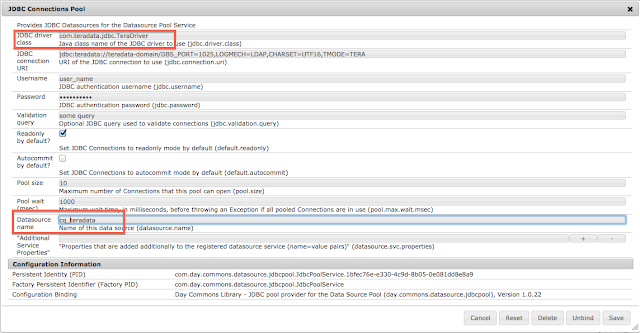
You can then test it using same code (Just use Teradata data source)
<%@page session="false"%><%
%><%@ page import="com.day.commons.datasource.poolservice.DataSourcePool" %><%
%><%@ page import="javax.sql.DataSource" %><%
%><%@ page import="java.sql.Connection" %><%
%><%@ page import="java.sql.SQLException" %><%
%><%@ page import="java.sql.Statement" %><%
%><%@ page import="java.sql.ResultSet"%><%
%><%@ page import="java.sql.PreparedStatement"%>
%><%@ page import="java.sql.DriverManager"%>
DataSourcePool dspService = sling.getService(DataSourcePool.class);
try {
DataSource ds = (DataSource) dspService.getDataSource("mysql_datasource");
if(ds != null) {
%><p>Obtained the datasource!</p><%
%><%
out.println("Trying to get connection Connection done");
final Connection connection = ds.getConnection();
out.println("Connection done");
final Statement statement = connection.createStatement();
out.println("Create Statement done");
final ResultSet resultSet = statement.executeQuery("some-query'");
int r=0;
while(resultSet.next()){
r=r+1;
}
resultSet.close();
%><p>Number of results: <%=r%></p><%
}
}catch (Exception e) {
%><p>error! <%=e.getMessage()%></p><%
}
You can also download OSGI version of teradata jar file from here
Note: If You want to call an instance of your Connection from Java class (Not from service) You can do something like this,
import java.sql.Connection;
import java.sql.DriverManager;
import java.sql.SQLException;
public class MySQLConnectionHelper {
private static volatile MySQLConnectionHelper mySQLConnectionHelper;
private MySQLConnectionHelper() {
try {
Class.forName("com.mysql.jdbc.Driver").newInstance();
//For Teradata Class.forName("com.teradata.jdbc.TeraDriver").newInstance();
} catch (InstantiationException e) {
// TODO Auto-generated catch block
e.printStackTrace();
} catch (IllegalAccessException e) {
// TODO Auto-generated catch block
e.printStackTrace();
} catch (ClassNotFoundException e) {
// TODO Auto-generated catch block
e.printStackTrace();
}
}
public static synchronized Connection getConnection(final String url,
final String uid, final String pwd) throws SQLException {
if (mySQLConnectionHelper == null) {
mySQLConnectionHelper = new MySQLConnectionHelper();
}
try {
return DriverManager.getConnection(url, uid, pwd);
} catch (SQLException e) {
throw e;
}
}
public static void close(Connection connection) {
try {
if (connection != null) {
connection.close();
}
} catch (SQLException e) {
e.printStackTrace();
}
}
}
No comments:
Post a Comment
If you have any doubts or questions, please let us know.